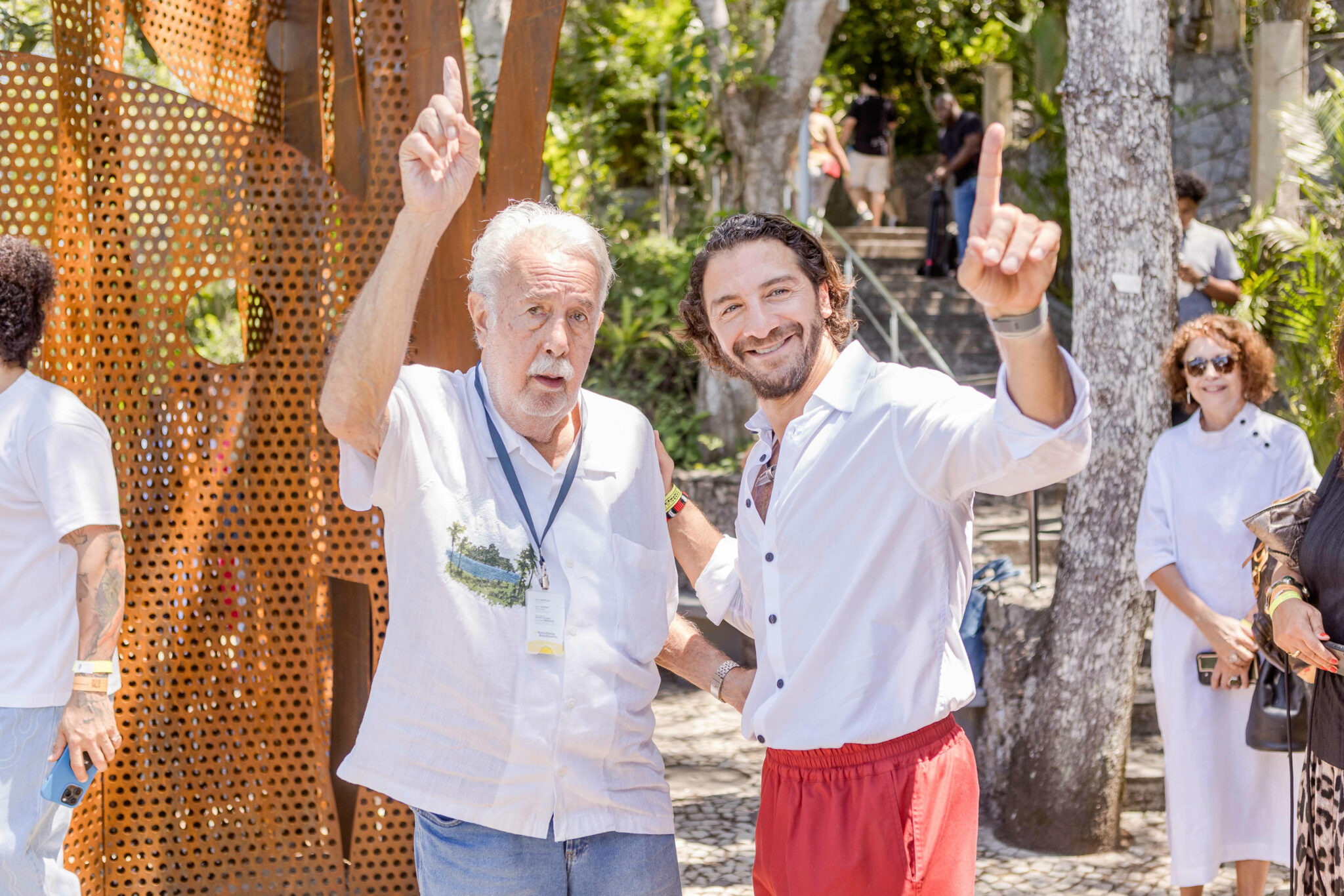The pleasure that comes from a great achievement is one of the things that drives me most in life. Yesterday, before hundreds of people, we inaugurated the Projeto Maravilha — a project that brings together nature, art, education, and technology at Parque Bondinho Pão de Açúcar®, reimagining the cultural experience at one of Brazil’s most important natural monuments, a historical and cultural heritage site of Rio de Janeiro.
A pioneering initiative, the project commissions major names in Brazilian art to produce new works. This first edition, curated by Ulisses Carrilho, presents works by the great Carlos Vergara in dialogue with the Atlantic Forest. It is a project with impact on both the cultural and tourism scenes of Rio, projecting Brazilian art to visitors from all over the world.
This inaugural edition also marks Vergara’s 60-year career. Now 83 years old, he continues in full artistic vigor, creating daily. One of the greatest joys that Maravilha has brought me was the opportunity to spend time with this master. Visiting his studio and witnessing his process was a transformative experience — a true life lesson.
When I invited him to be the first artist of the project, he accepted the challenge immediately: a courageous artist, Vergara conceived three large-format works, including one monumental piece weighing 700kg, in less than five months. “After 60 years of a career, I take the act of making art more seriously than ever,” he told me. “Sometimes I ask myself why I create a sculpture… The answer is: to create a place.”
And that is exactly what Vergara, in partnership with Projeto Maravilha, accomplished: he established a new space for contemporary art in the open air, the Bosque das Artes, located in an environmental preservation area 360 meters above sea level, at the summit of Sugarloaf Mountain.
Those who visit will witness Vergara’s poetic force in works such as Pauta Musical. Seven meters long, the piece resembles a musical score and integrates beautifully with the forest, in perfect harmony with local fauna. As birds land on the corten steel “lines,” they become the notes of an ephemeral composition. With deep poetry, the artist creates a meditative space that protests against the acceleration of life.
The Age of Stone celebrates the natural and historical beauty of Sugarloaf Mountain, formed around 600 million years ago. Using a mathematical code — a number written in full — the artist points to the tiny scale of human life. By making his own biographical time coexist with that of Sugarloaf, Vergara highlights the instability of forms and the inexorable passage of time. As the poet Manoel de Barros, one of his inspirations, wrote: “time only moves forward.”
A highlight of Maravilha, the monumental sculpture Parentheses evokes elements of nature, such as leaves and tree trunks, combined with three-meter-high punctuation marks that give the work its title. The opening of space between the parentheses and the perforations in the corten steel generate a dynamic interplay of light and shadow, which can be read as an attempt to engage in dialogue with the outside world. “In this work, the artist brings his ecological intelligence and proposes a horizontal, bipartite, and open form. Despite its large scale, the cutouts in the steel plate allow light to enter, integrating the sculpture into its surroundings without interrupting the landscape,” explains Carrilho.
“By changing your position, you can place whatever you want between parentheses. I placed a small replica in the window of my house, where I keep a tray with bird food. There, the birds eat between parentheses,” the artist says, amused.
The choice of corten steel for the three sculptures relates to the material’s properties, which allow for an evolving aesthetic through the layer of oxide that forms on its surface over time. However, Ulisses emphasizes that this choice is not only aesthetic but also political and poetic. Beyond ensuring durability, corten steel carries an opacity that resonates with Vergara’s work, whose meaning is not revealed immediately to the viewer. Its interaction with time creates a singular contrast with its surroundings, sparking reflections on cycles and the transformations of matter and life forms.
Delivering this maravilha to the people of Rio and to tourists from all over the world who visit Bondinho is a milestone. A singular achievement made possible by the dedication and tireless effort of a brilliant team. Just imagine the immense logistical challenge of transporting these works to the summit of Sugarloaf Mountain…
Mission accomplished with excellence — and carbon neutral! We offset all emissions generated by the exhibition, supporting projects that capture CO₂ and promote sustainability. I can proudly say that every visit, every step here, is part of a project designed to contribute to a greener and more conscious future, reinforcing our belief that culture can and should walk hand in hand with environmental preservation.
Now, we expect to welcome over 10,000 children to the project, and I have no doubt that a visit to the exhibition will change — even if just for an instant — the way they relate to the world. For this, we rely on an extensive digital journey — developed by my partner Thiago Yaak, a technology expert — which expands the audience’s experience and the cultural impact of Maravilha. We aim to draw attention to the importance of this preserved biome within a conservation unit, where our initiative is installed. I am fully convinced that art is the most effective and transformative tool of education, and that is why all the projects I develop through my company A-PONTE invest heavily in educational programs.
Projeto Maravilha was made possible through the Brazilian Cultural Incentive Law, with exclusive sponsorship from China National Petroleum Corporation (CNPC Brazil), support from Parque Bondinho Pão de Açúcar®, and production by A-PONTE.
